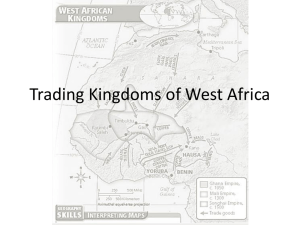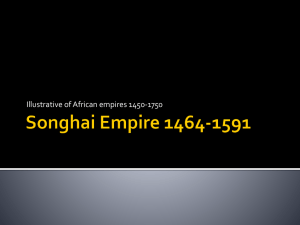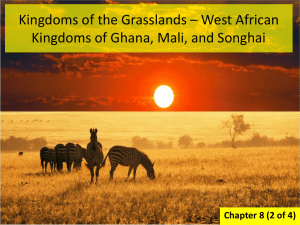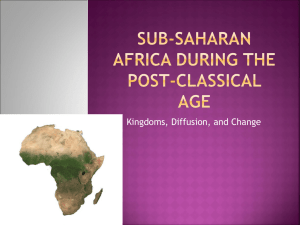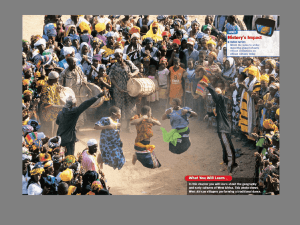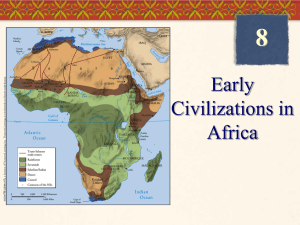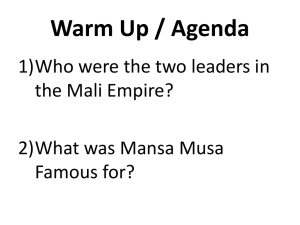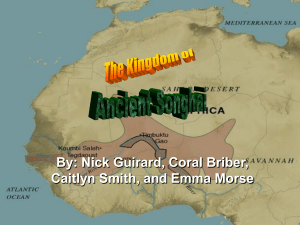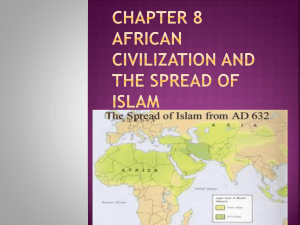Mansa Musa - tmsteam742
advertisement
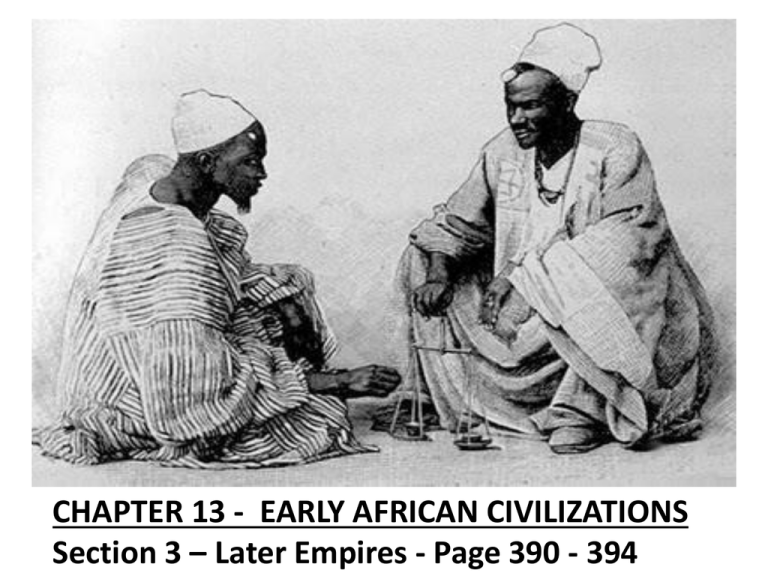
CHAPTER 13 - EARLY AFRICAN CIVILIZATIONS Section 3 – Later Empires - Page 390 - 394 VOCABULARY: - Sundiata - Mansa Musa - Sunni Ali - Askia the Great BIG IDEA Between 1000 and 1500, three great Geography, resources, culture, and kingdoms – Mi, trade influenced the growth of Mali, Songhai, and societies in West Africa. Great Zimbabwe – developed in Africa. MALI MAIN IDEA The empire of Mali reached its height Geography, culture, and under theresources, ruler trade influenced the growth of Mansa Musa, bt societies in West Africa. but the empire fell to invaders in the 1400’s. Like Ghana, Mali lays near the upper Niger River. This area’s fertile soil helped Mali to grow Mali’s location allowed its people to control trade on the river, thus allowing its empire to grow rich and powerful. Legend says – Mali’s rise to power began under the rule of Sundiata. SUNDIATA MAKES MALI AN EMPIRE Sundiata is the person who is looked at the person who started Mali. He was a great leader, “mansa” who cared for and brought many improvements to his country. Sundiata Let’s here the story of who Sundiata was…. When Sundiata was a boy, a harsh ruler (Samanguru) had conquered Mali. The griots of West Africa still tell the 700 year old story….. Samanguru Sundiata was one of twelve brothers who were the children of a Mandinka warrior. Samanguru was an especially grouchy ruler, who ruled the small state of Kaniaga, but he managed to conquer a great deal of West Africa. His taxes were high, and he failed to maintain law and order along the trade routes that once prospered in ancient Ghana. Anyway, Samanguru killed eleven of his brothers, but spared Sundiata because he believed the boy would soon die anyway. That mistake would lead to Samanguru’s downfall. The ill child boy recovered and eventually assembled an army to confront Samanguru. Sundiata’s forces killed Samanguru and destroyed his forces in the SUNDIATA Battle of Kirina in 1235. Sundiata then became mansa, or king, of a new empire that we know today as Mali. Mali means “where the (grouchy) king resides. SUNDIATA Ruler who took care of his people by bringing many improvements to his country. He was credited with creating the Empire of Mali Sundiata proved himself a great warrior, but he was less interested in power than in once again making West Africa a safe place to travel and trade. He converted to Islam, but only as a gesture of goodwill to the merchants and traders. To his own people, Sundiata was a champion of traditional West African religion. Sundiata then conquered nearby kingdoms, including Ghana in the 1230’s. Back to the textbook…… After they conquered Ghana, he took over the salt and gold trade. He also worked to improve agriculture in Mali. Sundiata had new farmlands cleared for beans, onions, rice, and other crops. Sundiata introduced a new crop – cotton. From the fibers people made clothing that was comfortable in the warm climate. They also sold cotton to other people. To keep order in his prosperous kingdom, Sundiata took power away from local leaders Local Leaders Each of the local leaders had the title “MANSA”, a title he also now took for himself. Mansas had both political and religious roles in society. MANSA Political Religious SOCIETY By taking on the religious authority of the mansas, Sundiata gained even more power in Mali MANSA = MORE POWER Sundiata died in 1255. Later rulers of Mali also took the title of mansa. Unlike Sundiata, most of these rulers were Muslims. MANSA MUSA Mali’s most famous ruler was a Muslim named Mansa Musa. Under his skillful leadership, Mali reached the height of its wealth, power, and fame in the 1300’s. MANSA MUSA Most famous ruler of Mali - it reached the height of its wealthy, power, and fame in the 1300’s under his leadership. He was Muslim and spread Islam through a large part of West Africa MANSA MUSA Because of Mansa Musa’s influence, Islam spread through a large part of West Africa, gaining many new believers. Mansa Musa ruled Mali for about 25 years, from 1312 to 1337. During that time, Mali added many important trade cities to its empire, including Timbuktu. - Religion was very important to Mansa Musa. In 1324, he left Mali on a pilgrimage to Mecca. Throughout his journey, Mansa Musa introduced his empire to the Islamic world. To show off his wealth and to spread trade with Mali, Mansa Musa went on a pilgrimage to the holy city of Mecca. The pilgrimage became legendary, and lasted about a year, from 1324-1325. Accompanying him was; about 12,000 slaves; 500 of them carrying 4 pound gold staffs (today’s money = 40 million), 80 camels loaded down with gold dust, the rest of them carrying clothing and food, his senior wife came, with her 500 attendants, and 10,000 of Mansa Musa's subjects came along. All together there were about 60,000 people traveling with gold at an estimated worth of $164 million in 2010 prices. In July of 1324 Mansa Musa's caravan arrived in Cairo, Egypt. There they spent and gave out so much gold that the value of gold declined (and it took over a year to economically recover.) Many Egyptian scholars came back to Mali with Mansa Musa. They wanted to know about the land where this rich and generous king lived. On the way back to Mali, Mansa Musa received news that his armies had recaptured Gao. When he heard this he made the decision to visit his new city and took a detour in his journey. When the caravan arrived in Gao they found that his armies had captured two hostages. The hostages were the sons of the Gao King. After his visit Mansa Musa decided to take them with him to his Court. There they were educated and had a better life than most. He spread Mali’s fame far and wide. Mansa Musa also supported education. He sent many scholars to study in Morocco. These scholars later set up schools in Mali. Mansa Musa stressed the importance of learning to read the Arabic language so that Muslims in his empire could read the Qur’an. To spread Islam in West Africa, Mansa Musa hired Muslim architects to build mosques throughout his empire. THE FALL OF MALI When Mansa Musa died, his son Maghan took the throne. Maghan was a weak ruler. When raiders from the southeast poured into Mali, he couldn’t stop them. The raiders set fire to Timbuktu’s great schools and mosques. Mali never fully recovered from this terrible blow. The empire continued to weaken and decline. In 1431, the Tuareg nomads from the Sahara, seized Timbuktu. The people living at the edges of Mali’s empire broke away. By 1500 nearly all of the lands the empire had once ruled were lost. Only a small area of Mali remained. What steps did Sundiata take to turn Mali into an empire? (SEQUENCING) Can you also answer these questions? A. Who was Sundiata? (IDENTIFY) B. What major river was important to the people of Mali? Why? (EXPLAIN) C. What effects did the ruler of Mansa Musa have on Mali and West Africa? (ELABORATE) D. After conquering nearby kingdoms, on what did Sundiata focus? (IDENTIFY) E. How did Sundiata consolidate political and religious power? (EXPLAIN) F. Why do you think it was important for the ruler of Mali to take away power from local leaders? (MAKE INFERENCES) G. To what religion did Mansa Musa belong? (IDENTIFY) H. To where did Mansa Musa travel in 1324? (RECALL) I. How did Mansa Musa spread his religion throughout Mali? (MAKING INFERENCES) J. What are two reasons for the decline of Mali? (RECALL) SONGHAI MAIN IDEA The Songhai built a new Islamic empire Geography, resources, culture, and in West Africa, trade influenced the growth of conquering many of in West Africa. of societies the lands that were once part of Mali. As Mali was reaching its height, a rival power was growing in the area – the Songhai Kingdom. It’s capital was at Gao. Songhai participated in the same trade that had made Ghana and Mali so rich. THE BUILDING OF AN EMPIRE In the 1300’s Mansa Musa conquered the Songhai, adding their lands to his empire. But, the Mali Empire weakened in the 1400’s. The Songhai rebelled and regained their freedom. The Songhai leaders were Muslims. Average Berber is 20% Negroid while the average Arab is only 5 to 10%. So too were many of the North African Berbers who traded in Western Africa. Because of this shared religion, the Berbers were willing to trade with the Songhai, who grew richer. As the Songhai gained in wealth, they expanded their territory and built an empire. Songhai’s expansion was led by Sunni Ali, who became ruler of the Songhai in 1464. SUNNI ALI Expanded Songhai and became its ruler in 1464. He promoted harmony in his country by participating in Muslim and other local religions Before he took over, the Songhai state had been disorganized and poorly run. As a ruler, Sunni Ali worked to unify, strengthen, and enlarge his empire. Much of the land he added to Songhai had been part of Mali. As king, Sunni Ali encouraged everyone in his empire to work together. To build religious harmony – he participated in both Muslim and local religions. As a result, he brought stability to Songhai. ASKIA THE GREAT Sunni Ali died in 1492, he was followed as king by his son Sunni Baru, who was not a Muslim. Songhai people feared that if Sunni Baru didn’t support Islam that they would lose their trade with Muslim lands and therefore rebelled against the king. The leader of the rebellion was a general named Muhammad Ture. After overthrowing Sunni Baru, Muhammad Ture chose the title ASKIA, a title of high military rank. Eventually, he became known as Askia the Great. ASKIA THE GREAT A great General who lead a rebellion against Sunni Baru. After the rebellion, he, Muhammad Ture, chose the title ASKIA – a title of high military rank. He supported Islam, education, and learning. Askia supported education and learning. Under his rule, Timbuktu flourished, drawing thousands to its universities, schools, libraries, and mosques. The city was especially known for the University of Sankore. People arrived there from North Africa and other places to study math, science, medicine, grammar, and law. Djenne’ was another city that became a center of learning. Most of Songhai’s traders were Muslim, as they gained influence in the empire, so did Islam. Askia, himself a devout Muslim, encouraged the growth of Islamic influence. He made many laws similar to those in other Muslim nations. To help maintain order, Askia set up five provinces within Songhai. He removed local leaders and appointed new governors who were loyal to him. Askia also created a professional army and specialized departments to oversee specific tasks. ASKIA THE GREAT c. 1443 – 1538 He became ruler of Songhai when he was nearly 50 years old and ruled for almost 35 years. Grave today for Askia the Great When he was in his 80’s, Askia went blind. His . son Musa forced him to leave the throne. He went to live on an island for 9 years until another son brought him back to the capital, where he died. His tomb is still one of the most honored places in all of West Africa SONGHAI FALLS TO MOROCCO A northern rival of Songhai, Morocco, wanted to gain control of Songhai’s salt mines. So, the Moroccan army set out for the heart of Songhai in 1591. Moroccan soldiers carried advanced weapons, including the terrible arquebus. The arquebus was an early form of a gun. The swords, spears, and bows used by Songhai’s warriors were no match for the Moroccans’ guns and cannons. The invaders destroyed Timbuktu and Gao. Changes in trade patterns completed Songhai’s fall. Overland trade declined as port cities on the Atlantic coast became more important. Africans south of Songhai and European merchants both preferred trading at Atlantic ports to dealing with Muslim traders. Slowly, the period of great West African Empire came to an end. What do you think was Askia’s greatest accomplishment? (EVALUATING) Can you also answer these questions? A. Who led the expansion of Songhai in the 1400s? (IDENTIFY) B. How did ASKIA the GREAT’S support of education affect Timbuktu? (EXPLAIN) C. Was the leader of the Songhai, Sunni Ali a strong or weak leaders? Why? (DRAW CONCLUSIONS) D. How did Askia the Great improve Timbuktu? (RECALL) E. How might Askia’s beliefs have helped him as a ruler? (MAKING INFERENCES) GREAT ZIMBABWE MAIN IDEA Great Zimbabwe Geography, resources, culture, and was a powerful trade influenced the growth of state that societies in West Africa. developed in southern Africa. Strong kingdoms also arose in other parts of Africa EX: Great Zimbabwe Great Zimbabwe was a powerful kingdom in Southern Africa. It was founded in the late 1000’s as a small trading and herding center. Gold mining increased in the area in the 1100’s. Farming expanded and the kingdom’s population grew. In time, Great Zimbabwe became the center of a large trading network. Trade made Great Zimbabwe’s rulers wealthy and powerful. They built a huge stone-walled fortress to protect their capital. In the 1400’s the gold trade declined. Deprived of its main source of wealth, Great Zimbabwe weakened. By the 1500, Zimbabwe was no longer a political and trading center. ZIMBABWE Political/Trading Center How was Great Zimbabwe similar to the empires of West Africa? (COMPARING) Can you also answer these questions? A. What made Great Zimbabwe’s rulers wealthy and powerful? (RECALL) B. What led to the decline of Great Zimbabwe? (ANALYZE) C. Where was Great Zimbabwe? When and why did it begin? (IDENTIFY) D. What led to the fall and the decline of Great Zimbabwe? (SUMMARIZE) Summarize – What did you learn about some of the later empires of Mali, Songhai, and Great Zimbabwe? Content for this presentation was gotten from: "Early African Civilizations." World History. : Houghton Mifflin Harcourt Publishing Company, 2012. . Print.
